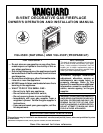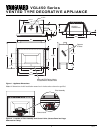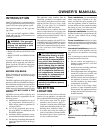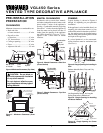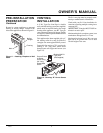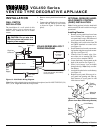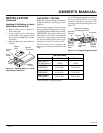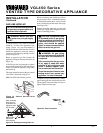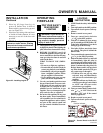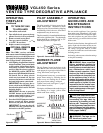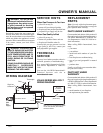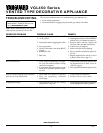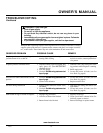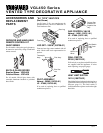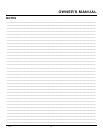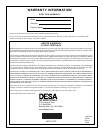
3
105704
OWNER’S MANUAL
Model VGL450 series is a radiant heat deco-
rative gas appliance that uses a millivolt gas
control valve and a pilot ignition system.
This appliance requires a 4" B-1 type vent-
ing system.
4" B-1 type vent NOT supplied by DESA.
Check with your "B" vent instructions for
installation guidelines.
This appliance, when installed, must be
electrically grounded in accordance with
local codes or, in the absence of local codes,
with the National Electrical Code, ANSI/
NFPA 70 or the CSA C22.1 CANADIAN
ELECTRICAL CODE for Canada.
The installation must conform with local
codes or, in the absence of local codes, with
the National Fuel Gas Code ANSI Z223.1 or
with the current CAN/CGA-B149[.1 OR .2]
Installation Codes for Canada.
This appliance complies with ANS Z21.50-
1998 and CAN/CGA 2.22-M98 Standard as
a VENTED DECORATIVE GAS APPLI-
ANCE and is tested and listed by the Ameri-
can Gas Association and Canadian Gas
Association.
INTRODUCTION
WARNING: This gas appli-
ance must not be connected to a
chimney flue servicing a solid
fuel burning appliance.
• Model VGL450N uses NATURAL GAS
ONLY.
• Model VGL450P uses PROPANE GAS
ONLY.
If you have any doubts as to which gas your
particular unit is approved and tested for,
please check the AGA/CGA rating plate
located behind the access panel (Figure 1,
page 2).
BEFORE YOU BEGIN
Before beginning the installation of your
appliance, read these instructions through
completely.
This DESA appliance and its approved com-
ponents are safe when installed according to
this installation manual and are operated as
recommended by DESA. Unless you use
DESA approved components tested for this
appliance, YOU MAY CAUSE A FIRE
HAZARD!
The DESA warranty will be voided by, and
DESA disclaims any responsibility for the
following actions :
A) Modification of the appliance or any of
the components manufactured by
DESA unless otherwise permitted in
writing by DESA.
B) Use of any component part not ap-
proved by DESA in combination with
this DESA appliance.
C) Installation and/or operation in a man-
ner other than instructed in this manual.
D) The burning of anything other than the
type of gas approved for use in this gas
appliance.
CAUTION: Installation and re-
pair should be done by a quali-
fied service person. The appli-
ance should be inspected before
use, and at least annually by a
qualified service person. More fre-
quent cleaning may be required
due to excessive lint from carpet-
ing, bedding material, pet hair,
etc. It is imperative that the con-
trol compartments, burners and
circulating air passageways of
the appliance be kept clean.
NOTICE: This appliance is not
intended to be used as a primary
source of heat.
To determine the safest and most efficient
location for your appliance, you must take
into consideration the following guidelines:
1. The location must allow for proper
clearances (see Clearances, page 4 ).
2. Consider a location where heat output
would not be affected by drafts, air con-
ditioning ducts, windows or doors.
3. A location that avoids the cutting of
joists or roof rafters will make installa-
tion easier. Figure 3 shows a plan view
of a few common locations.
SELECTING
LOCATION
Flush installations are recommended
where living space is limited or at a pre-
mium, and since the space required to en-
close the appliance would be located be-
yond an outside wall, this would also reduce
the cutting of joists, roof rafters and such.
Check local codes for any restrictions.
Projected installations can extend any
distance into the room. A projection may be
ideal for a new addition on an existing,
finished wall.
Corner installations make use of space
that may not normally be used and provides
a wider and more efficient range for radiant
heat transference.
Internal wall installations provide a dis-
creet option for room separation and can
also be ideal as an addition to an existing
wall.
Also, in selecting a location, the following
precautions must be observed:
1. Do not connect this appliance to a
chimney system used for a solid fuel
burning fireplace.
2. Install in an area providing ventilation
and adequate combustion air.
3. Due to high temperatures, the appliance
should be located out of traffic and
away from furniture and draperies.
4. NEVER obstruct the front opening of
the appliance or the flow of combus-
tion and ventilation air. Keep control
compartments accessible.
5. Do not locate in the vicinity where
gasoline or other flammable liquids
may be stored. The appliance area must
be kept clear and free from these com-
bustible materials.
Figure 3 - Possible Locations for Installing
Appliance
INTERNAL WALL
INSTALLATION
CORNER
INSTALLATION
FULL
PROJECTION
INSTALLATION
FLUSH
INSTALLATION



